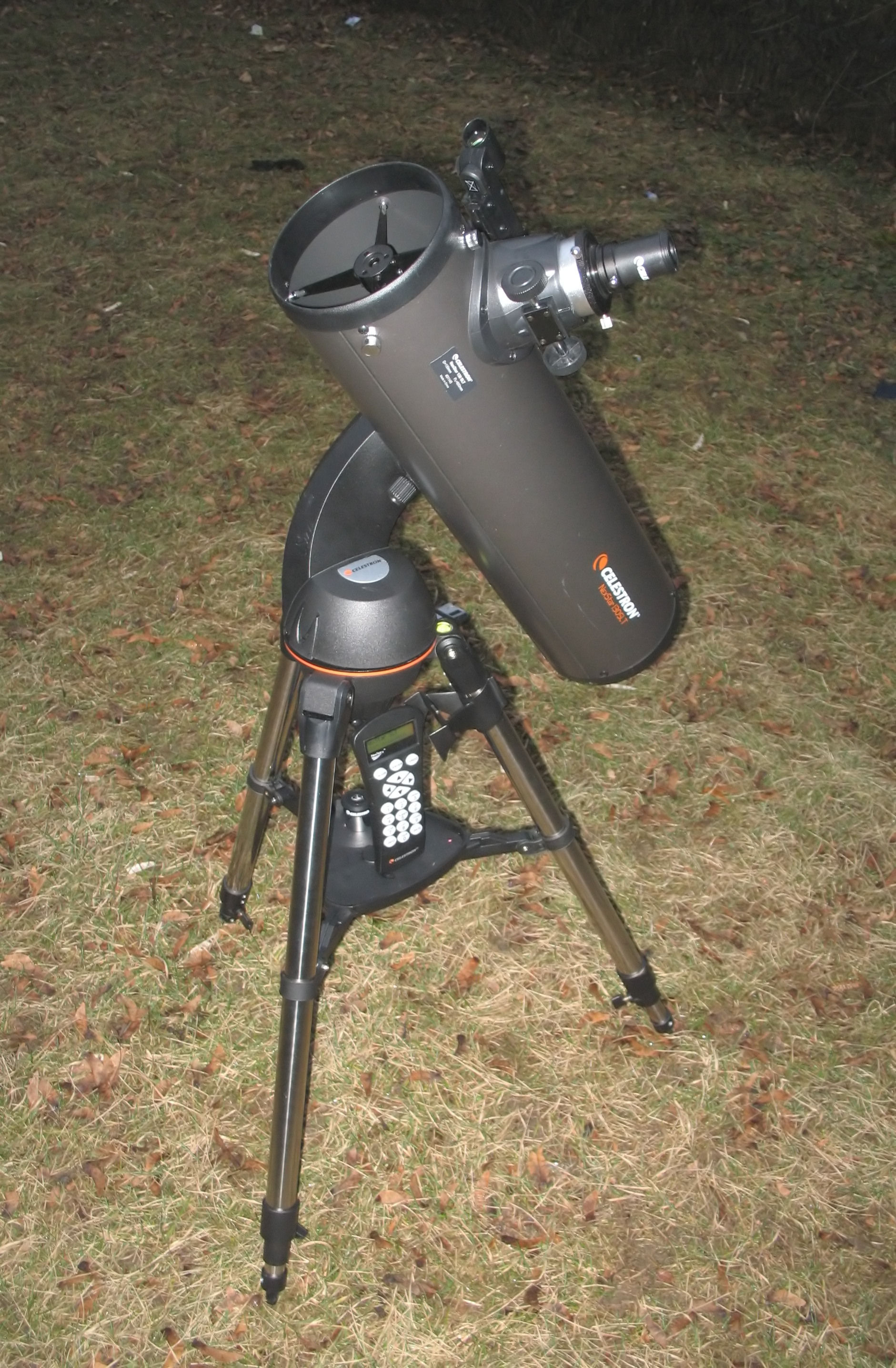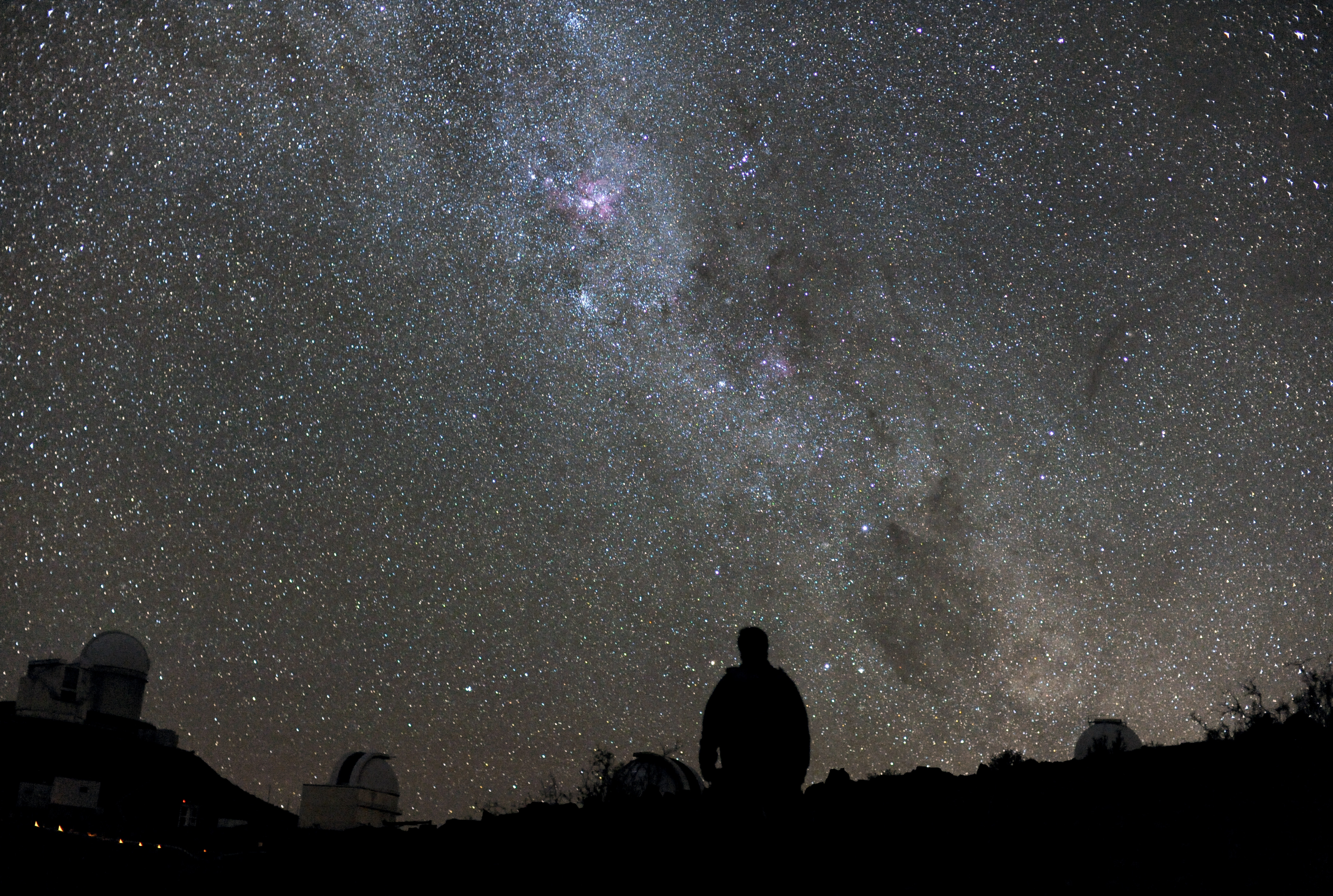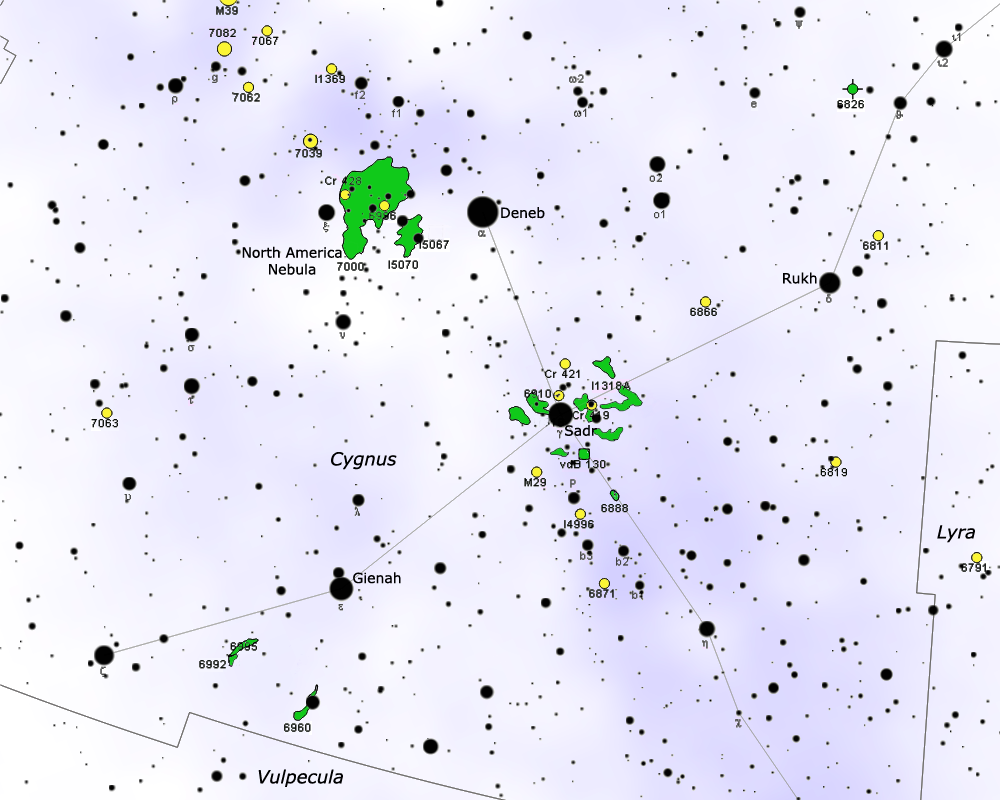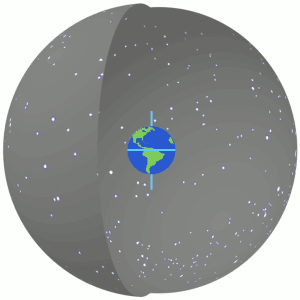|
GoTo Telescope
In amateur astronomy, "GoTo" refers to a type of telescope mount and related software that can automatically point a telescope at astronomical objects that the user selects. Both axes of a GoTo mount are driven by a motor and controlled by a computer. It may be either a microprocessor-based integrated controller or an external personal computer. This differs from the single-axis semi-automated tracking of a traditional clock-drive equatorial mount. The user can command the mount to point the telescope to the celestial coordinates that the user inputs, or to objects in a pre-programmed database including ones from the Messier catalogue, the New General Catalogue, and even major Solar System bodies (the Sun, Moon, and planets). Like a standard equatorial mount, equatorial GoTo mounts can track the night sky by driving the right ascension axis. Since both axes are computer controlled, GoTo technology also allows telescope manufacturers to add equatorial tracking to mechanically ... [...More Info...] [...Related Items...] OR: [Wikipedia] [Google] [Baidu] |
Night Sky
The night sky is the nighttime appearance of celestial objects like stars, planets, and the Moon, which are visible in a clear sky between sunset and sunrise, when the Sun is below the horizon. Natural light sources in a night sky include moonlight, starlight, and airglow, depending on location and timing. Aurorae light up the skies above the polar circles. Occasionally, a large coronal mass ejection from the Sun or simply high levels of solar wind may extend the phenomenon toward the Equator. The night sky and studies of it have a historical place in both ancient and modern cultures. In the past, for instance, farmers have used the status of the night sky as a calendar to determine when to plant crops. Many cultures have drawn constellations between stars in the sky, using them in association with legends and mythology about their deities. The history of astrology has generally been based on the belief that relationships between heavenly bodies influence or explain events on Ear ... [...More Info...] [...Related Items...] OR: [Wikipedia] [Google] [Baidu] |
List Of Telescope Types
The following are lists of devices categorized as types of telescopes or devices associated with telescopes. They are broken into major classifications with many variations due to professional, amateur, and commercial sub-types. Telescopes can be classified by optical design or mechanical design/construction. Telescopes can also be classified by where they are placed, such as space telescopes. One major determining factor is type of light, or particle being observed including devices referred to as "telescopes" that do not form an image or use optics. Some telescopes are classified by the task they perform; for example Solar telescopes are all designs that look at the Sun, Dobsonian telescopes are designed to be low cost and portable, Aerial telescopes overcame the optical shortcomings of 17th-century objective lenses, etc. List of optical telescope types Optical telescopes can be classified by three primary optical designs (refractor, reflector, or catadioptric), by sub-designs of ... [...More Info...] [...Related Items...] OR: [Wikipedia] [Google] [Baidu] |
List Of Telescope Parts And Construction
Hardware Accessories * Finderscope *Iron sight * Reflector (reflex) sight * Cheshire collimator: A simple tool to collimate a telescope Control * Clock drive * GoTo Mechanical construction * Mirror support cell * Serrurier truss *Silvering Mounts *Telescope mount - Types include: ** Altazimuth mount ** Equatorial mount *** Equatorial platform **** Poncet Platform *** Fork mount *** German equatorial mount *** Springfield mount Optics Mirrors and lenses are the critical light-bending components of a telescope. * Objective: The first lens or curved mirror that collects and focuses the incoming light. **Primary lens: The objective of a refracting telescope. **Primary mirror: The objective of a reflecting telescope. *Corrector plate: A full aperture negative lens placed before a primary mirror designed to correct the optical aberrations of the mirror. ** Schmidt corrector plate: An aspheric-shaped corrector plate used in the Schmidt telescope. ** Meniscus corrector: A menisc ... [...More Info...] [...Related Items...] OR: [Wikipedia] [Google] [Baidu] |
Tablet Computer
A tablet computer, commonly shortened to tablet, is a mobile device, typically with a mobile operating system and touchscreen display processing circuitry, and a rechargeable battery in a single, thin and flat package. Tablets, being computers, have similar capabilities, but lack some input/output (I/O) abilities that others have. Modern tablets largely resemble modern smartphones, the only differences being that tablets are relatively larger than smartphones, with screens or larger, measured diagonally, and may not support access to a cellular network. Unlike laptops (which have traditionally run off operating systems usually designed for desktops), tablets usually run mobile operating systems, alongside smartphones. The touchscreen display is operated by Gesture recognition, gestures executed by finger or digital pen (stylus), instead of the Computer mouse, mouse, touchpad, and Keyboard (computing), keyboard of larger computers. Portable computers can be classified according ... [...More Info...] [...Related Items...] OR: [Wikipedia] [Google] [Baidu] |
Smartphone
A smartphone is a mobile phone with advanced computing capabilities. It typically has a touchscreen interface, allowing users to access a wide range of applications and services, such as web browsing, email, and social media, as well as multimedia playback and Streaming media, streaming. Smartphones have built-in cameras, GPS navigation, and support for various communication methods, including voice calls, text messaging, and internet-based messaging apps. Smartphones are distinguished from older-design feature phones by their more advanced hardware capabilities and extensive mobile operating systems, access to the internet, business applications, Mobile payment, mobile payments, and multimedia functionality, including music, video, mobile gaming, gaming, Internet radio, radio, and Mobile television, television. Smartphones typically feature MOSFET, metal–oxide–semiconductor (MOS) integrated circuit (IC) chips, various sensors, and support for multiple wireless communicati ... [...More Info...] [...Related Items...] OR: [Wikipedia] [Google] [Baidu] |
Image Stacking
Speckle imaging comprises a range of high-resolution astronomical imaging techniques based on the analysis of large numbers of short exposures that freeze the variation of atmospheric turbulence. They can be divided into the shift-and-add ("''image stacking''") method and the speckle interferometry methods. These techniques can dramatically increase the resolution of ground-based telescopes, but are limited to bright targets. Explanation The principle of all the techniques is to take very short exposure images of astronomical targets, and then process those so as to remove the effects of astronomical seeing. Use of these techniques led to a number of discoveries, including thousands of binary stars that would otherwise appear as a single star to a visual observer working with a similar-sized telescope, and the first images of sunspot-like phenomena on other stars. Many of the techniques remain in wide use today, notably when imaging relatively bright targets. The resolution ... [...More Info...] [...Related Items...] OR: [Wikipedia] [Google] [Baidu] |
Deep-sky Object
A deep-sky object (DSO) is any astronomical object that is not an individual star or Solar System object (such as Sun, Moon, planet, comet, etc.). The classification is used for the most part by amateur astronomers to denote visually observed faint naked eye and Optical telescope, telescopic objects such as star clusters, nebulae and galaxy, galaxies. This distinction is practical and technical, implying a variety of instruments and techniques appropriate to observation, and does not distinguish the nature of the object itself. Origins and classification Classifying non-stellar astronomical objects began soon after the invention of the telescope. One of the earliest comprehensive lists was Charles Messier's 1774 Messier catalog, which included 103 "nebulae" and other faint fuzzy objects he considered a nuisance since they could be mistaken for comets, the objects he was actually searching for. As telescopes improved these faint nebulae would be broken into more descriptive scien ... [...More Info...] [...Related Items...] OR: [Wikipedia] [Google] [Baidu] |
Astrophotography
Astrophotography, also known as astronomical imaging, is the photography or imaging of astronomical objects, celestial events, or areas of the night sky. The first photograph of an astronomical object (the Moon) was taken in 1839, but it was not until the late 19th century that advances in technology allowed for detailed stellar photography. Besides being able to record the details of extended objects such as the Moon, Sun, and planets, modern astrophotography has the ability to image objects outside of the visible spectrum of the human eye such as dim stars, nebulae, and galaxy, galaxies. This is accomplished through long-exposure photography, long time exposure as both film and digital cameras can accumulate and sum photons over long periods of time or using specialized optical filters which limit the photons to a certain wavelength. Photography using extended exposure-times revolutionized the field of professional astronomical research, recording hundreds of thousands of new ... [...More Info...] [...Related Items...] OR: [Wikipedia] [Google] [Baidu] |
Declination
In astronomy, declination (abbreviated dec; symbol ''δ'') is one of the two angles that locate a point on the celestial sphere in the equatorial coordinate system, the other being hour angle. The declination angle is measured north (positive) or south (negative) of the celestial equator, along the hour circle passing through the point in question. The root of the word ''declination'' (Latin, ''declinatio'') means "a bending away" or "a bending down". It comes from the same root as the words ''incline'' ("bend forward") and ''recline'' ("bend backward"). In some 18th and 19th century astronomical texts, declination is given as ''North Pole Distance'' (N.P.D.), which is equivalent to 90 – (declination). For instance an object marked as declination −5 would have an N.P.D. of 95, and a declination of −90 (the south celestial pole) would have an N.P.D. of 180. Explanation Declination in astronomy is comparable to geographic latitude, projected onto the celestial sphere, and ... [...More Info...] [...Related Items...] OR: [Wikipedia] [Google] [Baidu] |
Azimuth
An azimuth (; from ) is the horizontal angle from a cardinal direction, most commonly north, in a local or observer-centric spherical coordinate system. Mathematically, the relative position vector from an observer ( origin) to a point of interest is projected perpendicularly onto a reference plane (the horizontal plane); the angle between the projected vector and a reference vector on the reference plane is called the azimuth. When used as a celestial coordinate, the azimuth is the horizontal direction of a star or other astronomical object in the sky. The star is the point of interest, the reference plane is the local area (e.g. a circular area with a 5 km radius at sea level) around an observer on Earth's surface, and the reference vector points to true north. The azimuth is the angle between the north vector and the star's vector on the horizontal plane. Azimuth is usually measured in degrees (°), in the positive range 0° to 360° or in the signed ... [...More Info...] [...Related Items...] OR: [Wikipedia] [Google] [Baidu] |







